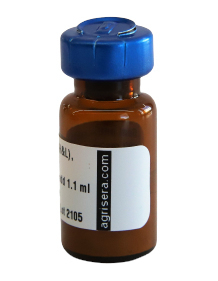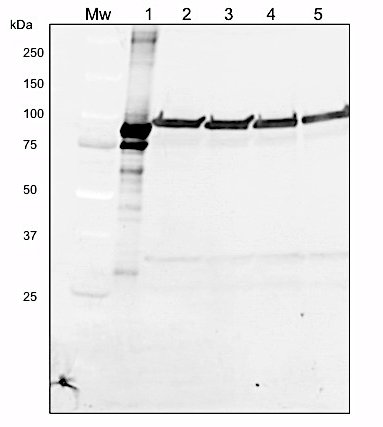1

Chicken anti-Rabbit IgG (H&L), DyLight® 488 conjugated
AS10 831 | Clonality: Polyclonal | Host: Chicken | Reactivity: Rabbit IgG (H&L)
- Product Info
-
Immunogen: Purified Rabbit IgG, whole molecule
Host: Chicken Clonality: Polyclonal Purity: Immunogen affinity purified chicken IgY. Format: Lyophilized Quantity: 1 mg Reconstitution: For reconstitution add 1.1 ml of sterile water. Let it stand 30 minutes at room temperature to dissolve. Prepare fresh working dilutions daily Storage: Store lyophilized material at 2-8°C. Product is stable for 4 weeks at 2-8°C after rehydration. For long time storage after reconstitution, dilute the antibody solution with glycerol to a final concentration of 50% glycerol and store as liquid at -20°C, to prevent loss of enzymatic activity. For example, if you have reconstituted 1 mg of antibody in 1.1 ml of sterile water add 1.1 ml of glycerol. Such solution will not freeze in -20°C, If you are using a 1:5000 dilution prior to diluting with glycerol, then you would need to use a 1:2500 dilution after adding glycerol. Prepare working dilution prior to use and then discard. Be sure to mix well but without foaming. Recommended dilution: 1 : 20-1 : 2000 for most applications - Application Examples
-
Application example 
Samples of Arabidopsis thaliana (2), Olea europaea (3), Lilium Longiflorum (4), Lupinus luteus (5) were ground in liquid nitrogen to a very fine powder using a mortar and pestle and resuspended in 1.5 ml of extraction buffer (4% SDS, 2% 2-mercaptoethanol, 2 mM PMSF, 100 mM Tris-HCl pH 8.5). The samples were incubated for 3 min at 80°C. Protein suspensions were clarified by centrifugation at 13,500 g for 10 min at room temperature and the resulting supernatants were used. Total proteins (25 µg per sample) were separated by SDS-PAGE on CriterionTMTGXTM Precast Gel (Bio-Rad, USA) using CriterionTM Cell apparatus (Bio-Rad). Proteins were electroblotted onto a PVDF membrane using Trans-Blot® TurboTM Transfer Pack (Bio-Rad) in a Trans-Blot® TurboTM Transfer System (Bio-Rad). The membrane was blocked for 1 h in solution containing 1 % (w/v) non-fat dry milk in TRIS-buffered saline (TBS) buffer, pH 7.4. The membrane was incubated in the primary antibody at a dilution of 1: 1000 in TBS buffer containing 1 % (w/v) non-fat dry milk over night at 4°C with agitation. A DyLight 488 conjugated anti-rabbit IgG (AS10 831, Agrisera), diluted 1:2000 in TBS buffer for 2 h, served as the secondary antibody. The signal was detected in a Pharos FX molecular imager (Bio-Rad). Line 1 contains LOX protein from Sigma.
Courtesy of Dr. Agnieszka Zienkiewicz, CSIC, Spain - Additional Information
-
Additional information: Conjugate is present in 10 mM Sodium Phosphate, 0.15 M Sodium Chloride, pH 7.2, 1 % (w/v) BSA, Protease/IgG free. 0.05 % (w/v) sodium azide is added as preservative.
Based on immunoelectrophoresis, this antibody reacts with: heavy (γ) chains on rabbit IgG, light chains on all rabbit immunoglobulins
No reactivity is observed to: non-immunoglobulin rabbit serum proteins
- Background
-
Background: Chicken anti-Rabbit IgG (H&L) - DyLight®488 Conjugate is a secondary antibody conjugated to DyLight®488, which binds to Rabbit IgG (H&L) in immunological assays.
DyLight® 488 Amax = 493 nm, Emax = 519 nm. Antibodies are purified using solid phase Rabbit IgG (H&L)
DyLight® is a registered trade mark of Thermofisher Inc., and its subsidaries.
- Product Citations
-
Selected references: Kovaleva et al. (2017). Regulation of Petunia Pollen Tube Growth by Phytohormones: Identification of Their Potential Targets. DOI:10.17265/2161-6256/2016.04.004. (immunolocalization) - Protocols
- Antibody protocols
- Reviews:
-
This product doesn't have any reviews.




